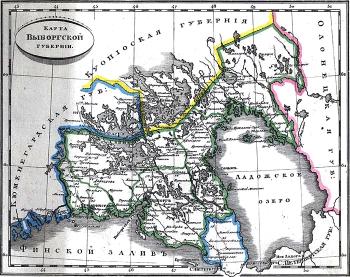Articles
/
Eparhy of Korelia
Eparhy of Korelia
Subject /
Religion. Church/Confession life
Eparchy of Korelia (Korelian and Oreshsky/Oreshkovsky Eparchy; according to other names - Korelian and Koporsky). It was founded in 1595 after Tyavzinsky Treaty of Peace with Sweden when the town of Korela (now the town of Priozersk) was given back to Russia. An aim of the Korelian Eparchy establishing was the consolidation of Russia in the North-West, particularly in the Karelian Isthmus. Christianity had already appeared in Karelia in the 11th century in connection with the activity of Orthodox missionaries from Novgorod. In 1227 according to the initiative of Prince Yaroslav Vsevolodovich the christening of almost all Karelian population took place. Korela, the main town of the new eparchy, was a big spiritual centre. In the 15th century there was the residence of the Archbishop of Novgorod in Korela, in the 1560s in the town and neighbouring villages there were nine churches of the Gorodensky pogost, including the Cathedral of the Resurrection, and five monasteries. In the Korela uyezd also there were six parishes (nearby of present-day settlements of Gromovo, Sosnovo, Kurkiyoki, Salmi, the town of Sortavala, Ilomansky Lake); the Valaam Monastery, Konevets Monastery, the Convent of the Nativity of the Mother of God, the Sennoy Monastery on Ladoga Lake were particularly important. Most of churches and monasteries were ravaged by Swedes, in particular during the war of 1593-1593. Silvester, an archimandrite of the Moscow Monastery of St. Simon, was appointed as the first bishop of Karelia (1595-1613). The Korela parish, Koporye parish, Oreshek parish, according to some information the Ladoga parish and the whole Olonets region were under his supervision. He lived in Korela and in 1609-1611 organised the defence of the town from Swedes. Paul, the next bishop, governed the eparchy during 1613-1616. According to the Stolbovsky treaty of 1617 the territory of the Karelian Isthmus was passed to Sweden and the Eparchy of Korelia temporarily ceased to be in existence. Originally the church construction of the Karelian region was realized by metropolitan Makary II (1619-1626). The Orthodox population was oppressed by the Sweden authorities. In 1685, under Kornily, the Metropolitan of Novgorod (1674-1695), according to the agreement the Russian and Swedish governments the Eparchy of Korelia was resumed with the status of suffragancy. As Keksgolm was under Sweden, Novgorod became the residence of the new archiereus bishop Leonty. In 1690 Leonty was exiled into Suzdal. Joel, the next bishop, was appointed only in 1708 as a vicar under Mitropolitan Joel. After his death in 1712 Aaron (Yeropkin), a former archimandrite of the Novgorod Yuryev Monastery, was appointed as the bishop of Korelia, but he continued to live in Yuryev. Keksgolm was included into the Synodal centre of the suffragancy in 1723. During 1723-1725 Joachim was the bishop of Karelia; during 1734-1740 this position was occupied by archbishop Joseph; in 1740 bishop Ambrose, a famous preacher, became the bishop of Karelia and in 1742 bishop Marcellus occupied this position. In 1758 the suffragancy became to name as Keksgolm and Ladoga officially. All four bishops, who had the title, were vicars of the Novgorod archbishop (Mitropolitan from 1762) Demetrius (Sechenov): Joasaph (1758-1759), Parthenius (1759-1761), St. Tychon (1761-1763, a spiritual writer, ascetic), Innocent (1763, a preacher and writer). The Eparchy was completely cancelled in 1763.
Authors
Bertash, Aleksandr Vitalyevich
Persons
Aaron (Afanasy Vladimirovich Yeropkin)
Amvrosy (Andrey Yushkevich)
Dimitry (Daniil Andreyevich Sechenov), metropolitan
Innokenty (Nechayev), bishop
Ioakim, bishop
Ioasaf (Khotuntsevsky or Khotunevich), bishop
Ioil (Vyazmitin)
Iosif, bishop
Job, metropolitan
Kornily (Kosma), metropolitan
Leonty, bishop of korelia and Ladoga
Makary II, metropolitan of Novgorod and Velikiye Luki
Markell (Nikolay Romanovich Rodyshevsky), bishop
Parfeny (Sopkovsky), bishop
Pavel, bishop of Korelia and Oreshkovsk
Silvester, bishop of Korelia
Tikhon (Timofey Vasilyevich Sokolov), bishop
Yaroslav Vsevolodovich, Prince
Geography
Historical Toponyms/Gorodensky Pogost
Leningrad Oblast, the/Priozersk District/Gromovo Settlement
Topographical landmarks/Karelian Isthmus, the
Historical Toponyms/Keksgolm Town
Historical Toponyms/Korela
Historical Toponyms/Ladoga
Topographical landmarks/Ladoga Lake
Leningrad Oblast, the/Priozersk District/Priozersk Town
Leningrad Oblast, the/Priozersk District/Sosnovo Settlement
Bibliography
Дмитриев А.П. История Корельской (Кексгольмской) епархии // Вуокса. Приозерский краеведческий альманах. Вып. 1. Приозерск, 2000
Мануил (Лемешевский), митрополит. Русские православные иерархи периода с 992 по 1892 г. (включительно). Т. 1-3. М., 2002-2004
Subject Index
Konevets Munastery of the Nativity of the Virgin Mary
Mentioned in articles:
|
hidden
|
Eparhy of Olonets and Kargopol
The Eparchy of Olonets and Kargopol. Othodox monasteries and churches of the Olonets region (the territories of present-day Korelia, partly of the Vologda and Leningrad Regions) were originally included into the Eparchy of Novgorod. The foundation... more
|
|
|
hidden
|
"Vuoksa", a Priozersk local history anthology
"Vuoksa", a Priozersk local history anthology. It was published from 1999 till 2003 according to the initiative the workers of the Fortress-museum "Korela" and local historians with the Financial Support of the Administration of the Priozersk... more
|
|
|
|
hidden
|
Vyborg Gubernia, the
VYBORG GUBERNIA, historic adm. and territorial unit of Russia and Finland. It occupied the northern part of the Karelian Isthmus, Northern Coast of Ladoga, south-east of the current Finland. In the Middle Ages, V. G. was the places of ethnogenesis... more
|
|
|
|





